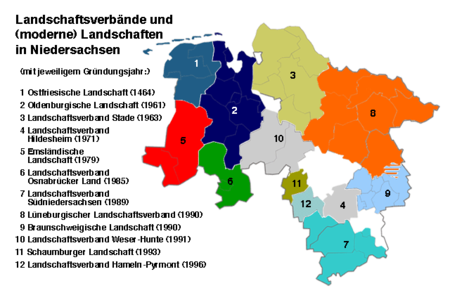Landscapes and landscape associations in Lower Saxony
In Lower Saxony there are organizations called Landscapes and Landscapes Associations, whose main task today is to maintain regional culture and identity in their respective geographical areas of responsibility. These tasks were also contractually assigned to them by the state of Lower Saxony.
Terms

The use of the terms “landscape” and “landscape association” differs in the various regions of Lower Saxony. In the area of the three smaller former predecessor countries of Lower Saxony, namely in Braunschweig , Oldenburg and Schaumburg , regional organizations were founded in the post-war period to maintain culture and identity, which call themselves landscapes .
In the area of the former state of Hanover , on the other hand, traditional forms of organization called landscape have existed since the Middle Ages . In the post-war period, together with local authorities and other institutions, they also founded modern regional organizations for the cultivation of regional culture and identity, but here the name landscape association was chosen to avoid confusion. There is no regional association in the Hanover region . Its tasks are performed here by the Hanover region itself, which is at the district level.
The six historic Hanoverian landscapes emerged from the representative offices of the former principalities ( estates ) and today, as corporations under public law, belong to the corresponding landscape associations, which in turn are registered associations. It is a matter of:
- the Calenberg-Grubenhagensche landscape , member of the Regional Association of South Lower Saxony and the Regional Association of Hameln-Pyrmont ,
- the landscape of the former Principality of Hildesheim , member of the Hildesheim Regional Association ,
- the landscape of the former principality of Lüneburg , member of the Lüneburg Regional Association ,
- the landscape of the duchies of Bremen and Verden , member of the Stade Regional Association ,
- the Hoya-Diepholzsche landscape , member of the landscape association Weser-Hunte and
- the landscape of the former principality of Osnabrück , member of the landscape association Osnabrücker Land .
Another historical landscape in Lower Saxony is the East Frisian landscape , which is a corporation under public law and a landscape association. Other regional associations in Lower Saxony are:
- the Brunswick landscape ,
- the Emsland landscape ,
- the Oldenburg landscape ,
- the regional association Harz (Lower Saxony part) and
- the Schaumburg landscape .
history
Originally, the clergy , the regional knighthoods (owners of the goods eligible for state assembly) and the larger cities were represented in the landscapes . In the middle of the 19th century, the landowning farmers took the place of the clergy and from then on formed the third estate. While the knights and cities still send their deputies themselves, the representatives of the farmers are elected by the district councils today on the basis of proposals from the regional agricultural associations.
In addition, there are institutions that see themselves in a loose tradition of these historical landscapes and feel committed to cultural concerns and regional identity. In areas where there are no longer any historical landscapes with an estate constitution, these modern associations also call themselves landscapes , since there is no risk of confusion with the older institutions. Examples are the Emsland landscape and the Oldenburg landscape . This naming should also express the fact that one wants to revive and revive a historical regional identity.
In the area of the former Kingdom of Hanover , on the other hand, the name Landschaftsverband was mostly chosen for the modern institutions , because the landscapes composed by the estates still exist there (they are not shown in the map below). It was from these that the initiative to found the new associations came in the second half of the 20th century. In addition to the districts and cities, these historical landscapes are members of the respective landscape association.
Tasks and legal basis
The tasks of the Lower Saxony landscapes and landscape associations are limited to promoting culture. In contrast, they also perform social tasks in North Rhine-Westphalia. The regional associations in Lower Saxony are therefore significantly smaller in terms of financial volume and workforce. The East Frisian Landscape , founded in 1464, is the only one that emerged from the earlier estates in a continuous process and is by far the oldest. You and the Oldenburg landscape are corporations under public law . All other landscape associations are registered and non-profit associations.
After the dissolution of the administrative districts in Lower Saxony in 2004, contracts were concluded between the associations and the state of Lower Saxony in which the landscape associations were officially identified as regional carriers of cultural tasks.
Web links
- AG of the landscapes and landscape associations in Lower Saxony with links to the websites of the individual associations
- The six historic Hanoverian landscapes

